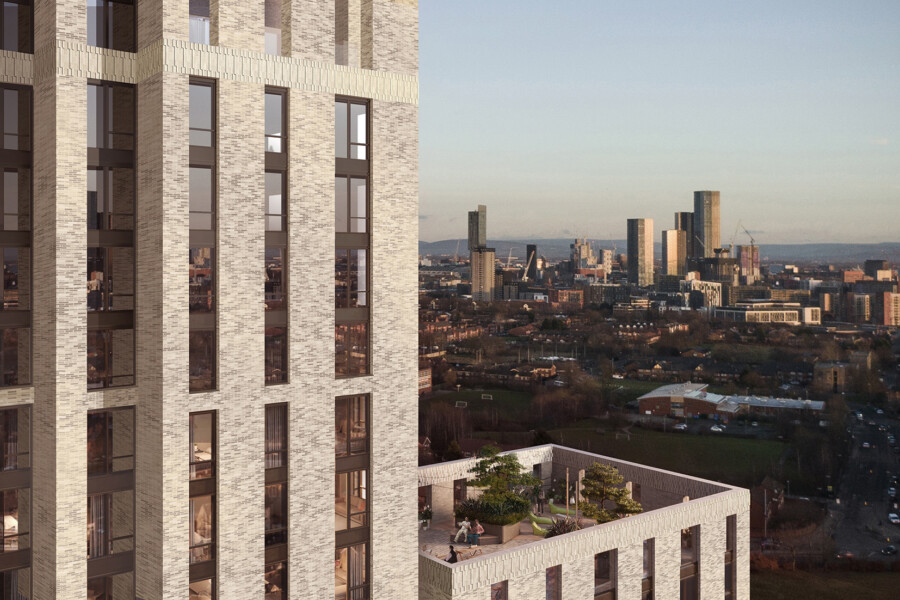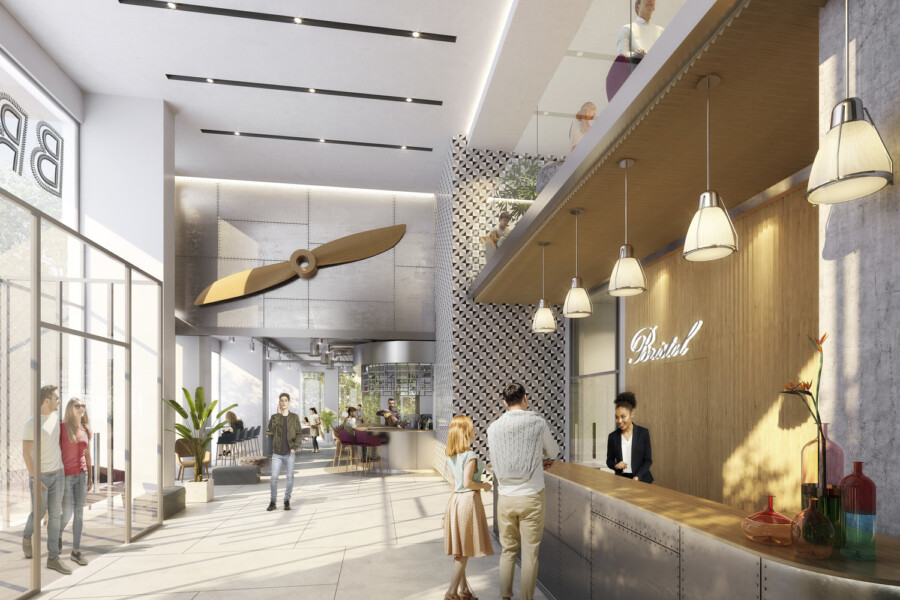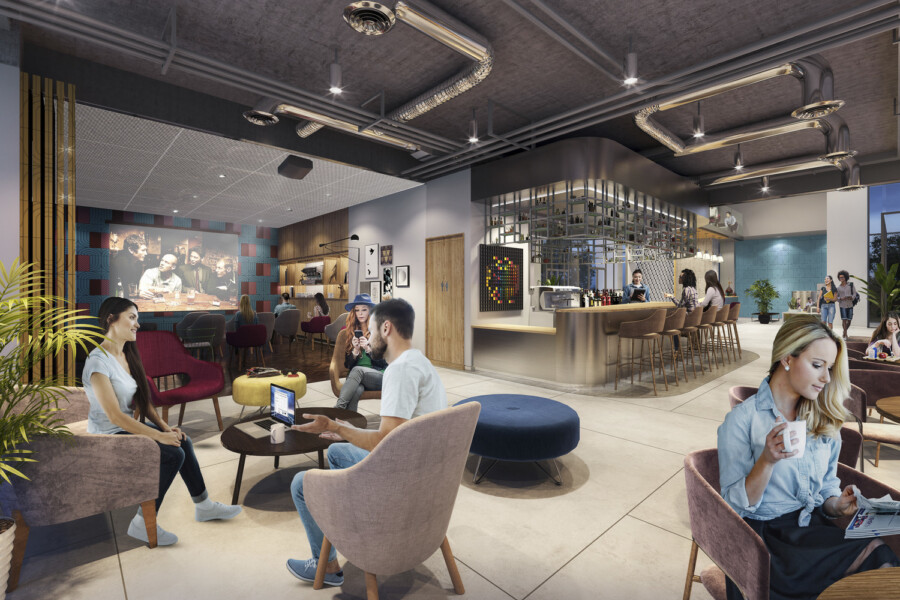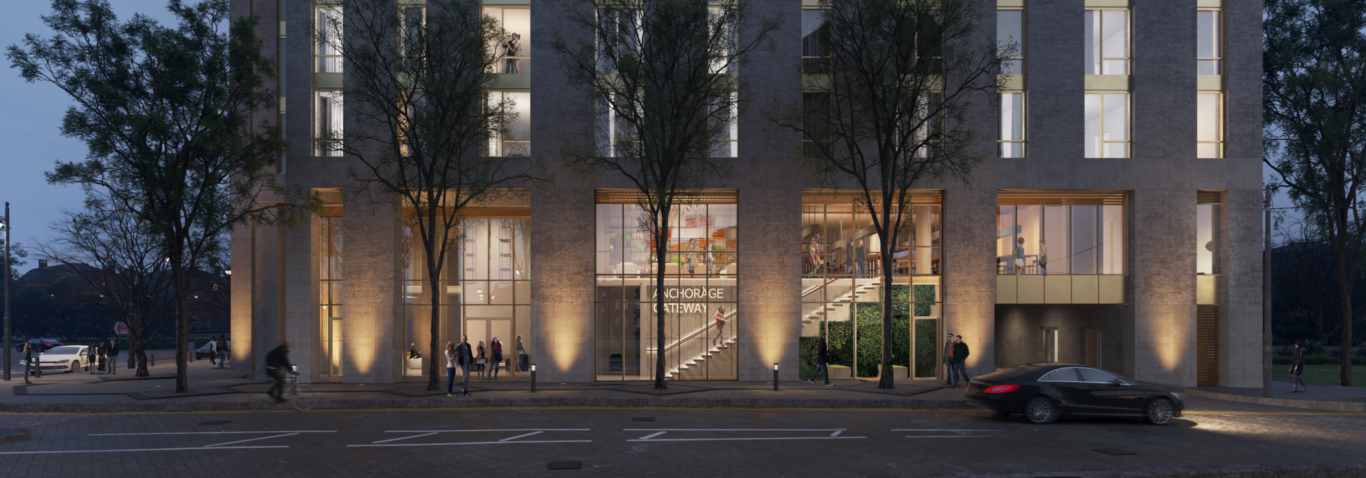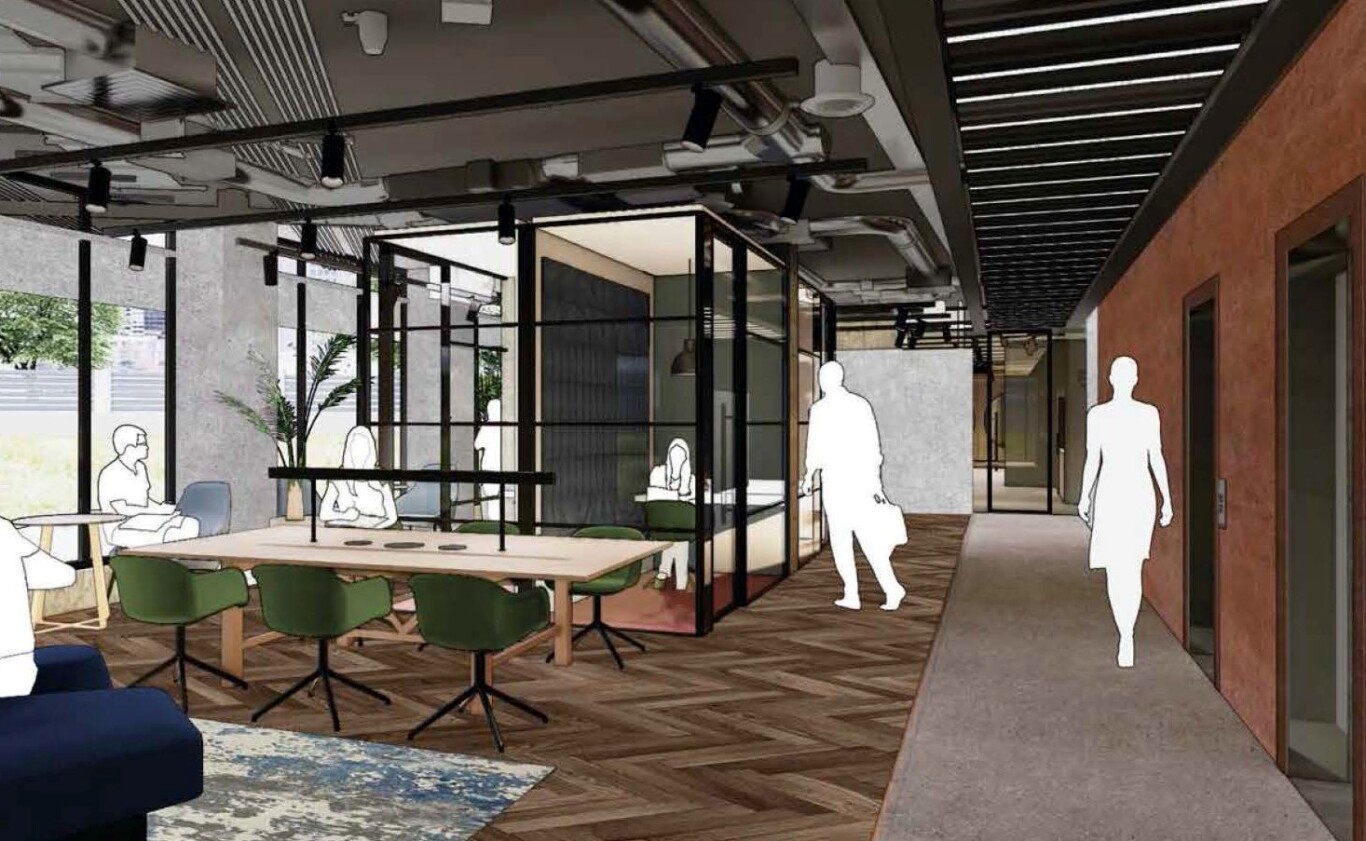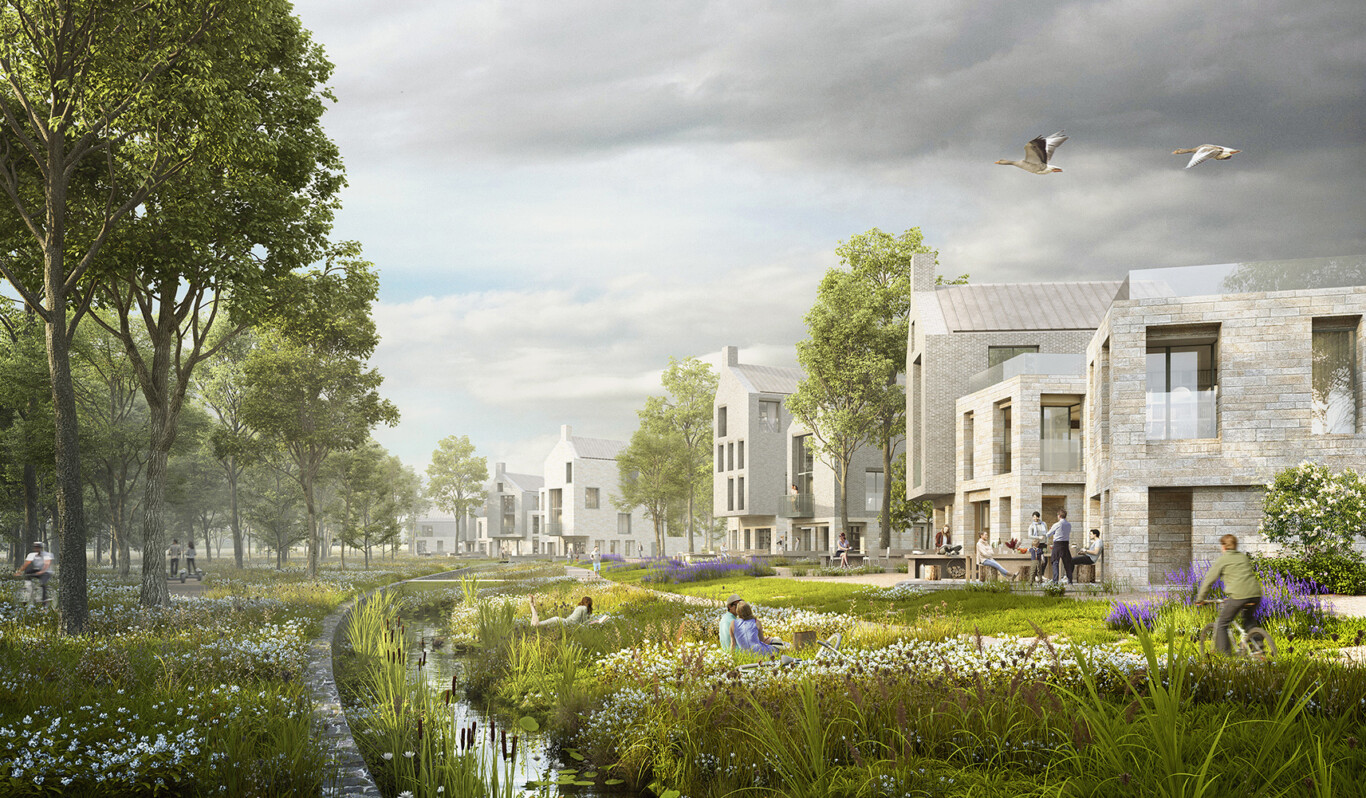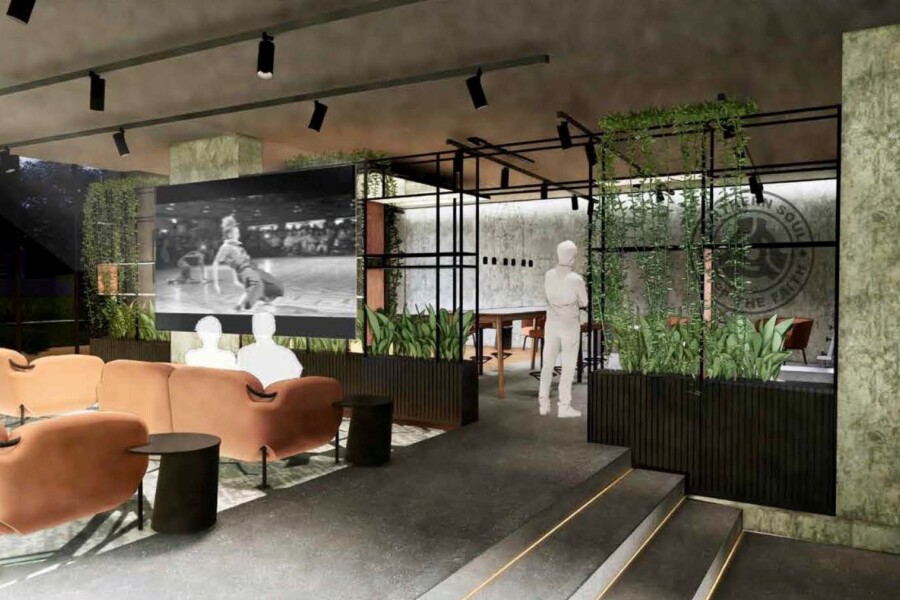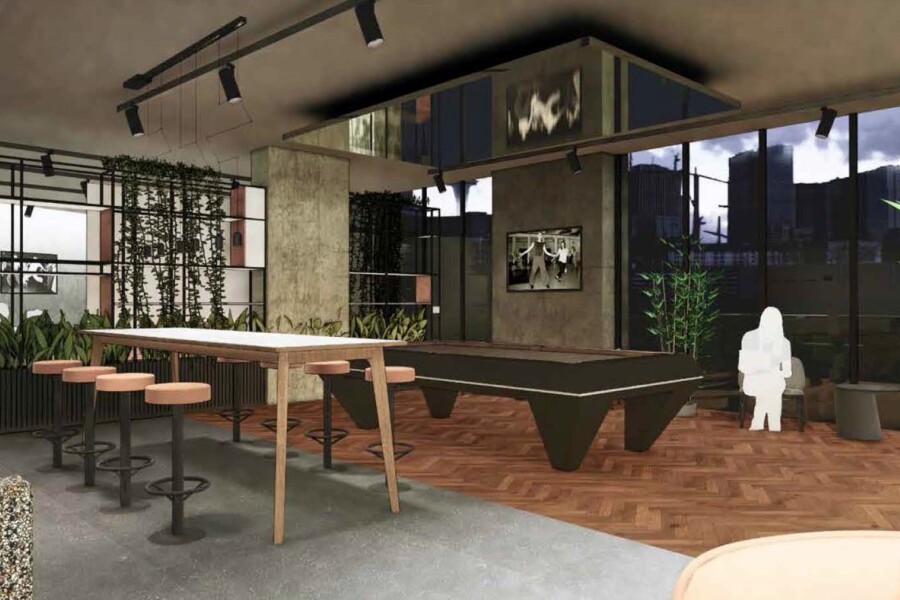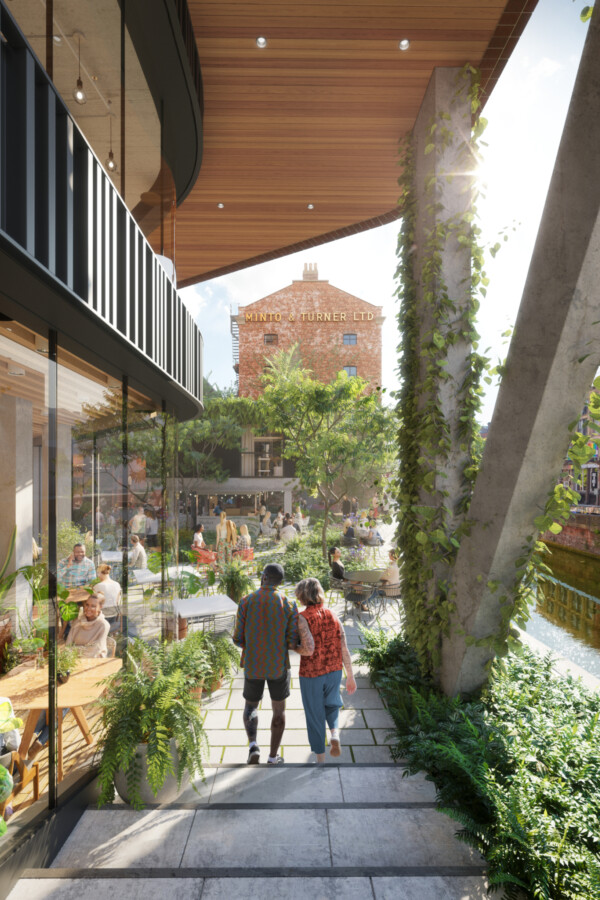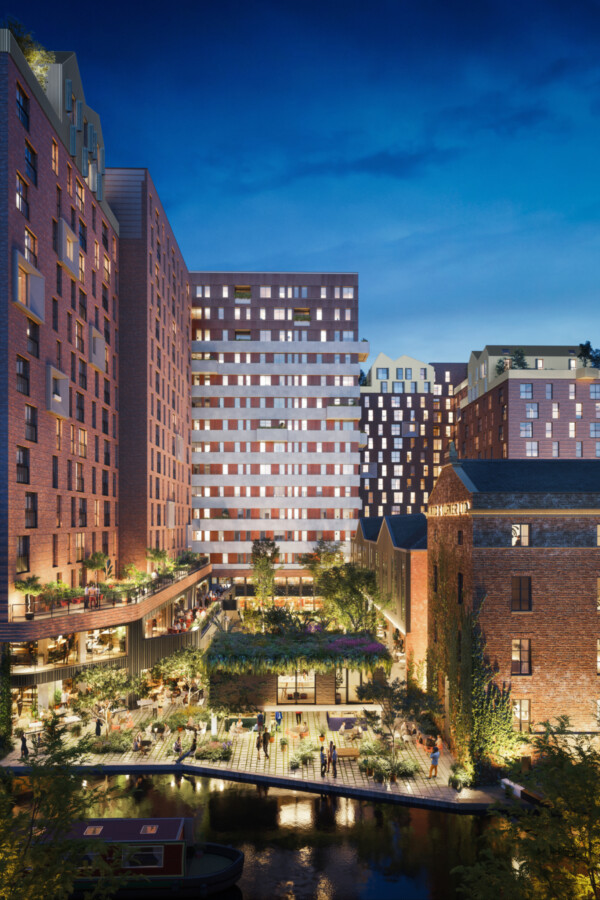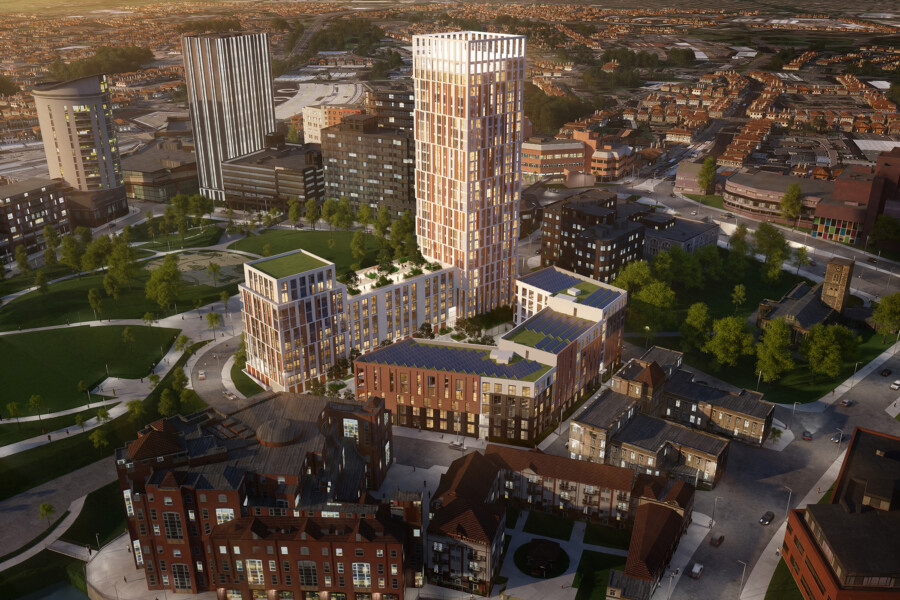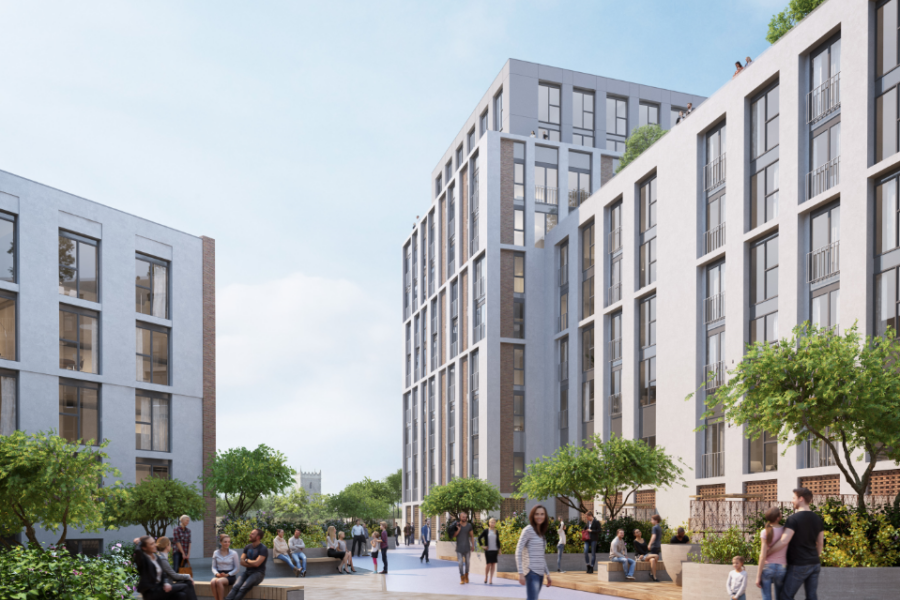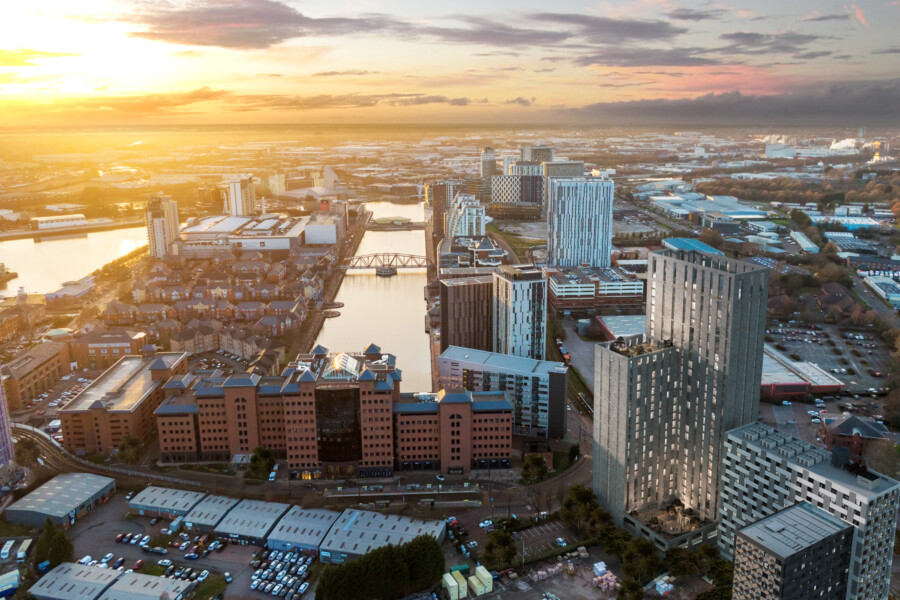
Post-COVID design: How Build-to-Rent offers a template for the way ahead
Diseño post-COVID: el Build-to-Rent como modelo del camino a seguir
COVID-19 has thrown many assumptions about the way we live upside-down, causing developers to reassess their approach to the design and management of the residential buildings they create in response. In this paper, Residential Director Michael Swiszczowski look at how the Build-to-Rent format is already well-placed to deal with some of the key issues raised by the pandemic, both short- and long-term. He makes the case that the sense of community offered by Build-to-Rent developments is a key asset in situations like the current pandemic, while the amenities they provide will be very attractive to the increasing numbers of people looking to work from home in the long term.
El COVID-19 ha incorporado muchas desafíos sobre la forma en que vivimos lo cual ha provocado que los desarrolladores reevalúen sus enfoques sobre el diseño y la gestión de los edificios residenciales. En este artículo, el director residencial Michael Swiszczowski analiza cómo el formato Build-to-Rent ya lleva tiempo bien posicionado para abordar algunos de los problemas clave planteados por la pandemia, bien a medio como a largo plazo. Argumentamos aqui que el sentido de comunidad que ofrecen los desarrollos Build-to-Rent es un activo clave en situaciones como la pandemia actual mientras que las comodidades que brindan serán muy atractivas para el creciente número de personas que buscan trabajar desde casa y actualizar sus modos de vida.
COVID-19 has thrown many assumptions about the way we live upside-down, causing developers to reassess their approach to the design and management of the residential buildings they create in response. In this paper, Residential Director Michael Swiszczowski look at how the Build-to-Rent format is already well-placed to deal with some of the key issues raised by the pandemic, both short- and long-term. He makes the case that the sense of community offered by Build-to-Rent developments is a key asset in situations like the current pandemic, while the amenities they provide will be very attractive to the increasing numbers of people looking to work from home in the long term.
The COVID-19 pandemic and lockdown has changed perceptions of the nature of work for many, with more people working from home on a long-term or permanent basis. The sudden growth of remote working has required developers and designers to think again about the spaces we create, as demand grows for homes which are equipped to facilitate the phenomenon.
In addition, there is increasing interest in how residential design can improve in terms of health security, decreasing the risk of infections being transmitted from person to person, whether this be COVID or any other pathogen. Related to that, questions are being asked about how suitable our residences are for lockdown or quarantine-type situations – particularly when we consider that many people endured the 2020 lockdown in small apartments without outdoor spaces or suitable areas in which to work.
We believe that one residential format, Build-to-Rent, is ideally placed to provide solutions for the challenges thrown up by the recent pandemic.
The concept behind Build-to-Rent and the requirements of COVID compliance seem on the surface to be contradictory; Build-to-Rent is all about customer engagement, bringing people together, drawing them out of their apartments and breaking down the barriers between landlord and resident, whereas COVID compliance requires barriers to go up.
However, this is not the case – on the contrary, the Build-to-Rent format can provide a great service during times such as the current pandemic precisely because those barriers are going up. The core ethos of Build-to-Rent is about encouraging a sense of community (both digital and physical) and a culture of service – these are vital components at a time when people need to help and look out for each other more than ever.
Below, we look at how Build-to-Rent developments can help their residents to adapt to these new issues – working from home, lockdown or quarantine situations and health and welfare.
La pandemia y el confinamiento COVID-19 ha cambiado la percepción de la naturaleza del trabajo para muchos, con más personas trabajando desde casa a largo plazo o de forma permanente. El repentino crecimiento del trabajo a distancia ha obligado a los desarrolladores y diseñadores a volver a pensar en los espacios que creamos, a medida que crece la demanda de hogares equipados para facilitar este convulso momento.
Además, existe un interés creciente en cómo implementar el diseño residencial para mejorar en términos de seguridad sanitaria, por ejemplo disminuyendo el riesgo de transmisión de infecciones de persona a persona, ya sea COVID o cualquier otro patógeno. En relación con eso, se están haciendo preguntas sobre cuánto son de adecuadas nuestras viviendas para situaciones de confinamiento o cuarentena, particularmente cuando consideramos que muchas personas soportaron el encierro de 2020 en apartamentos pequeños sin espacios al aire libre o áreas adecuadas para trabajar.
Creemos que hay un formato residencial, el Build-to-Rent, que está en una posición ideal para brindar soluciones a los desafíos planteados por la reciente pandemia.
The concept behind Build-to-Rent and the requirements of COVID compliance seem on the surface to be contradictory; Build-to-Rent is all about customer engagement, bringing people together, drawing them out of their apartments and breaking down the barriers between landlord and resident, whereas COVID compliance requires barriers to go up.
However, this is not the case – on the contrary, the Build-to-Rent format can provide a great service during times such as the current pandemic precisely because those barriers are going up. The core ethos of Build-to-Rent is about encouraging a sense of community (both digital and physical) and a culture of service – these are vital components at a time when people need to help and look out for each other more than ever.
Below, we look at how Build-to-Rent developments can help their residents to adapt to these new issues – working from home, lockdown or quarantine situations and health and welfare.
El concepto detrás de Build-to-Rent y los requisitos de cumplimiento de COVID parecen ser contradictorios en la superficie ya que el Build-to-Rent tiene que ver con conceptos como la participación del cliente, socializar y unir a las personas, sacarlas de sus apartamentos y romper ciertas barreras entre el propietario y el usuario, mientras que el cumplimiento de COVID requiere que las barreras aumenten.
Sin embargo, este no es el caso ya que el formato Build-to-Rent puede brindar un gran servicio en momentos como la pandemia actual precisamente porque esas barreras están aumentando. El espíritu central de Build-to-Rent consiste en fomentar un sentido de comunidad (tanto digital como físico) y una cultura de servicio; estos son componentes vitales en un momento en que las personas necesitan ayudarse y cuidarse unos a otros más que nunca.
A continuación analizamos cómo los desarrollos Build-to-Rent pueden ayudar a sus residentes a adaptarse a estos nuevos problemas: trabajar desde el hogar, situaciones de confinamiento o cuarentena y el crucial asunto de la salud y el bienestar.
Working from home
A home office space and capability is now a crucial consideration for many people when looking for somewhere to live – working from bedrooms or using ironing boards as desks is not sustainable in the long term. The challenge for designers and developers is to create suitable home working environments without having much, if any, extra floorspace to play with.
One answer is to provide flexible, easily adapted spaces and furniture. The use of open-plan interiors allows people to adapt the spaces in which they live in a way which suits their specific needs. A designated space could be designed to adapt for different uses at different times, using, for example, foldable, built-in desks and chairs which can be simply “put away” when not in use.
Another approach is to rethink how space is used more generally. At our Flax Place Build-to-Rent development in Leeds, for example, one of the key features of the residences will be that residents will be able to easily adapt space to use for remote working if they need it. The apartments offer bedrooms with walk-in wardrobes, one half of which is configured so that it can remain as wardrobe space, be used for storage or can be a generous office desk space, well-lit and served by electrical sockets.
We believe that it is psychologically important to disconnect from work in the evening and, where apartment space is used for remote working, a partition to visually close off the space can be a useful means of marking the transition from workspace to rest / sleep space.
Obviously, a prerequisite for successful remote working is excellent digital connectivity, which requires design that facilitates uninterrupted WiFi signals, good mobile phone signals and well-placed electrical sockets, often with USB charging. Adding more sockets adds to the capital cost of the development, but we believe that is well worth it because of the flexibility it gives users in terms of when and how they work – an important consideration for people in the market for a new home if they work remotely even only some of the time.
In Build-to-Rent developments, there is shared amenity space, and the above principles can be extended to those. Why not provide shared workspaces dedicated to remote working? This would combine the advantages of remote working while recreating the communal element of being in an office with colleagues with whom you can chat and share ideas. Placing co-working spaces within the amenity spaces of Build-to-Rent developments is becoming a popular option among developers in the sector and we are currently considering such an arrangement for our Anchorage Gateway development in Manchester, where we are creating a flexible multipurpose space which could possibly be used for co-working during the day and then as a residents’ lounge in the evening and at weekends.
As a response to the pandemic, shared amenity spaces can be adapted for the short-to-medium-term to enable residents to use them as co-working spaces. For the long term, such co-working offers could become a permanent feature, possibly operated by external companies in a branded environment, open to the public as well as residents. Such a move could prove mutually beneficial for residents, operators and the wider community, although it would possibly necessitate a different relationship between the development and the street in terms of branding, entrances and the division of public and private space.
Lockdown or quarantine-type situations
When people have to isolate at home, whether individually or collectively, several aspects of life which we take for granted can become difficult or impossible. Fitness, for example, can be hard to maintain when you are forced to stay at home without access to outdoor spaces or commercial gyms in which to work out.
Access to a home gym or a space for exercise can therefore make a crucial difference in such situations. Build-to-Rent developments have a major advantage here because shared amenities, such as gyms, can be accessed and used safely without having to leave the building, so long as rigorous health security protocols are followed. Our design for the much-anticipated Castle Park View residential development in Bristol city centre, which includes a mix of Build-to-Rent and affordable homes, provides just such a gym for residents to share securely.
In any lockdown-type situation, Build-to-Rent operators can be in constant contact with residents to ensure they are able to manage, particularly those who are more vulnerable. They can allocate informal spaces where management can interact with residents, with distancing measures in place when necessary. In this way, an aspect of the Build-to-Rent experience which was initially set up for convenience – the digital and physical interfaces between residents and operators – has taken on a much more important function, providing crucial help, security and peace of mind for residents at a difficult time.
Residents can be made to feel connected with each other and with the management as part of one community ecosystem, with a concierge on hand to assist 24-hours-a-day and the use of residents’ apps becoming a norm for many. Whole buildings, if well designed, can be managed by a skeleton crew of as low as three but, when support is needed, it’s there – for example emptying rubbish for isolating residents or bringing food, shopping and deliveries straight to their apartment doors rather than residents coming to the delivery reception area as they normally would (the latter is a convenient function for residents which means that they are not required to be at home to collect deliveries).
Health and wellbeing
A major priority for developers and designers is to ensure that the physical and mental health of residents is factored into the way a development is designed and operated.
Build-to-Rent is about drawing people out of their apartments via amenities and social events, but this can be a problem in a pandemic. To prevent residents becoming effective prisoners within their apartments, with all the attendant physical and mental health challenges that can bring, operators can COVID-proof amenities such as gyms, with residents booking slots via an app, apparatus being distanced and regular, thorough sanitising of all surfaces. Gathering amenities such as gyms and workspaces under one roof provides much greater control over the health security of the whole offer than having separate buildings for each – one of the great advantages of the format.
As buildings become more equipped with smart technology, hands-free operation of their functions through touchless lifts and sensor-operated toilets, lights and doors, the opportunities for pathogens to be transmitted can be reduced.
In terms of mental health, social isolation can be devastating. Build-to-Rent offers more community engagement, with shared spaces and amenities, residents’ apps and social events allowing everyone to get to know each other and to keep an eye on each other’s welfare. Both management and fellow residents can ensure that nobody is socially isolated.
To ensure that shared spaces and interactions are safe to use, a number of health security measures and protocols can be implemented in common areas:
- Touch-free devices and automatic doors.
- Hand sanitising stations in key areas, including at the main entrance, as well as possibly providing PPE such as masks and gloves.
- Air filtration systems to remove pathogens from the interior environment.
- Incorporating copper and copper alloys, silver ion coatings and other anti-microbial materials (which kill the proteins at the core of viruses etc. within minutes).
- Avoiding horizontal surfaces where pathogens can accumulate in dust or, where that is not possible, ensuring that they are easily reached and capable of being thoroughly cleaned regularly.
- UV lights to “wash” shared rooms completely within 15 minutes, killing all pathogens within.
The best-equipped residential format
Although COVID-19 has been very disruptive, socially and economically as well as in terms of illnesses and fatalities, most people anticipate that the pandemic will pass in the medium term and that life will return to something like what we previously considered to be normal.
However, the pandemic has possibly created a permanent shift in some aspects of life, whether that be an increased awareness of environmental hygiene, a stronger awareness of the importance of community or a greater prevalence of people working from home.
The Build-to-Rent format is already well placed to help accommodate those changes. The challenge for designers and operators is to optimise designs and processes so that the format can be showcased as the residential model best equipped for post-COVID living.
Trabajando desde casa
El espacio y la capacidad para tener una oficina en casa es ahora una consideración crucial para muchas personas cuando buscan un lugar para vivir: trabajar desde los dormitorios o usar tablas de planchar como escritorios no es sostenible a largo plazo. El desafío para los diseñadores y desarrolladores es crear entornos de trabajo domésticos adecuados donde no hay mucho espacio adicional, si es que lo hay, para combinar distintos diseños y opciones.
Una respuesta es proporcionar espacios y mobiliario flexibles y de fácil adaptación. El uso de interiores diáfanos permite a las personas adaptar los espacios en los que viven de una manera que se adapte a sus necesidades específicas. Un espacio específico podría diseñarse para adaptarse a diferentes usos en diferentes momentos, utilizando, por ejemplo, escritorios y sillas plegables y empotrados que se pueden "guardar" simplemente cuando no se usan.
Another approach is to rethink how space is used more generally. At our Flax Place Build-to-Rent development in Leeds, for example, one of the key features of the residences will be that residents will be able to easily adapt space to use for remote working if they need it. The apartments offer bedrooms with walk-in wardrobes, one half of which is configured so that it can remain as wardrobe space, be used for storage or can be a generous office desk space, well-lit and served by electrical sockets.
Otro enfoque es repensar cómo se usa el espacio de manera más general. En nuestro desarrollo Flax Place Build-to-Rent en Leeds, por ejemplo, una de las características clave de las residencias será que los habitantes podrán adaptar fácilmente el espacio para usarlo en el trabajo remoto si lo necesitan. Los apartamentos ofrecen dormitorios con vestidores, la mitad de los cuales están configurados para que pueda permanecer también como, por ejemplo de guardarropa y ser utilizados para almacenamiento o quizá pudiera ser un espacio de escritorio generoso, bien iluminado y con toma de corriente.
Kampus Build-to-rent scheme, Manchester
Flax Place Leeds, 350 apartamentos BtR en torres de 11 y 15 alturas
We believe that it is psychologically important to disconnect from work in the evening and, where apartment space is used for remote working, a partition to visually close off the space can be a useful means of marking the transition from workspace to rest / sleep space.
Obviously, a prerequisite for successful remote working is excellent digital connectivity, which requires design that facilitates uninterrupted WiFi signals, good mobile phone signals and well-placed electrical sockets, often with USB charging. Adding more sockets adds to the capital cost of the development, but we believe that is well worth it because of the flexibility it gives users in terms of when and how they work – an important consideration for people in the market for a new home if they work remotely even only some of the time.
In Build-to-Rent developments, there is shared amenity space, and the above principles can be extended to those. Why not provide shared workspaces dedicated to remote working? This would combine the advantages of remote working while recreating the communal element of being in an office with colleagues with whom you can chat and share ideas. Placing co-working spaces within the amenity spaces of Build-to-Rent developments is becoming a popular option among developers in the sector and we are currently considering such an arrangement for our Anchorage Gateway development in Manchester, where we are creating a flexible multipurpose space which could possibly be used for co-working during the day and then as a residents’ lounge in the evening and at weekends.
Creemos que es psicológicamente importante desconectarse del trabajo por la noche y, cuando el espacio del apartamento se utiliza para trabajar a distancia, una partición para cerrar visualmente el espacio puede ser un medio útil para marcar la transición del espacio de trabajo al espacio de descanso / sueño.
Obviamente, un requisito previo para el éxito del trabajo remoto es una excelente conectividad digital, que requiere un diseño que facilite señales WiFi ininterrumpidas, buenas señales de teléfonos móviles y enchufes eléctricos bien ubicados, a menudo con carga USB. Agregar más enchufes aumenta el costo de capital del desarrollo, pero creemos que vale la pena debido a la flexibilidad que brinda a los usuarios en términos de cuándo y cómo trabajar, lo cual es una consideración importante para las personas en el mercado residencial si trabajar de forma remota, incluso solo algunas veces.
En los desarrollos Build-to-Rent hay un espacio de servicios compartido y los principios anteriores pueden extenderse a ellos. ¿Por qué no proporcionar espacios de trabajo compartidos dedicados al teletrabajo?. Esto combinaría las ventajas del trabajo remoto mientras recrea el elemento común de estar en una oficina con colegas con los que puede charlar y compartir ideas. Colocar espacios de coworking dentro de los espacios de servicios de los desarrollos Build-to-Rent se está convirtiendo en una opción popular entre los desarrolladores del sector y actualmente estamos considerando una situación de este tipo para nuestro desarrollo Anchorage Gateway en Manchester, donde estamos creando un espacio flexible de usos múltiples que posiblemente podría usarse para el trabajo conjunto durante el día y luego como sala de estar para residentes por la noche y los fines de semana.
As a response to the pandemic, shared amenity spaces can be adapted for the short-to-medium-term to enable residents to use them as co-working spaces. For the long term, such co-working offers could become a permanent feature, possibly operated by external companies in a branded environment, open to the public as well as residents. Such a move could prove mutually beneficial for residents, operators and the wider community, although it would possibly necessitate a different relationship between the development and the street in terms of branding, entrances and the division of public and private space.
Como respuesta a la pandemia los espacios de servicios compartidos se pueden adaptar a corto y medio plazo para permitir que los residentes los utilicen como espacios de trabajo comunitario. A largo plazo estas ofertas de coworking podrían convertirse en una característica permanente, posiblemente operada por empresas externas en un entorno de marca y abierto tanto al público como a los residentes. Tal movimiento podría resultar mutuamente beneficioso para los residentes, para los operadores y para la comunidad en general, aunque posiblemente requeriría una relación diferente entre el proyecto y el ámbito urbano en términos de marca, entradas o la propia división del espacio público y privado.
Lockdown or quarantine-type situations
When people have to isolate at home, whether individually or collectively, several aspects of life which we take for granted can become difficult or impossible. Fitness, for example, can be hard to maintain when you are forced to stay at home without access to outdoor spaces or commercial gyms in which to work out.
Access to a home gym or a space for exercise can therefore make a crucial difference in such situations. Build-to-Rent developments have a major advantage here because shared amenities, such as gyms, can be accessed and used safely without having to leave the building, so long as rigorous health security protocols are followed. Our design for the much-anticipated Castle Park View residential development in Bristol city centre, which includes a mix of Build-to-Rent and affordable homes, provides just such a gym for residents to share securely.
In any lockdown-type situation, Build-to-Rent operators can be in constant contact with residents to ensure they are able to manage, particularly those who are more vulnerable. They can allocate informal spaces where management can interact with residents, with distancing measures in place when necessary. In this way, an aspect of the Build-to-Rent experience which was initially set up for convenience – the digital and physical interfaces between residents and operators – has taken on a much more important function, providing crucial help, security and peace of mind for residents at a difficult time.
Residents can be made to feel connected with each other and with the management as part of one community ecosystem, with a concierge on hand to assist 24-hours-a-day and the use of residents’ apps becoming a norm for many. Whole buildings, if well designed, can be managed by a skeleton crew of as low as three but, when support is needed, it’s there – for example emptying rubbish for isolating residents or bringing food, shopping and deliveries straight to their apartment doors rather than residents coming to the delivery reception area as they normally would (the latter is a convenient function for residents which means that they are not required to be at home to collect deliveries).
Situaciones de confinamiento o cuarentena
Cuando las personas tienen que aislarse en casa, ya sea individual o colectivamente, varios aspectos de la vida que damos por sentados pueden volverse difíciles o imposibles. La forma física, por ejemplo, puede ser difícil de mantener cuando se ve obligado a quedarse en casa sin acceso a espacios al aire libre o gimnasios en los que hacer ejercicio.
Por lo tanto, el acceso a un gimnasio en casa o un espacio para hacer ejercicio puede marcar una diferencia crucial en tales situaciones. Los desarrollos construidos para alquilar tienen una gran ventaja aquí porque se puede acceder y usar servicios compartidos, como gimnasios, de manera segura sin tener que salir del edificio, siempre que se sigan protocolos rigurosos de seguridad sanitaria. Nuestro diseño para el tan esperado desarrollo residencial Castle Park View, en el centro de la ciudad de Bristol, incluye una combinación de viviendas construidas para alquilar y asequibles además de ofrecer un gimnasio de este tipo para que los residentes lo compartan de forma segura.
In any lockdown-type situation, Build-to-Rent operators can be in constant contact with residents to ensure they are able to manage, particularly those who are more vulnerable. They can allocate informal spaces where management can interact with residents, with distancing measures in place when necessary. In this way, an aspect of the Build-to-Rent experience which was initially set up for convenience – the digital and physical interfaces between residents and operators – has taken on a much more important function, providing crucial help, security and peace of mind for residents at a difficult time.
Residents can be made to feel connected with each other and with the management as part of one community ecosystem, with a concierge on hand to assist 24-hours-a-day and the use of residents’ apps becoming a norm for many. Whole buildings, if well designed, can be managed by a skeleton crew of as low as three but, when support is needed, it’s there – for example emptying rubbish for isolating residents or bringing food, shopping and deliveries straight to their apartment doors rather than residents coming to the delivery reception area as they normally would (the latter is a convenient function for residents which means that they are not required to be at home to collect deliveries).
En cualquier situación de confinamiento los operadores de Build-to-Rent pueden estar en contacto constante con los residentes para asegurarse de que puedan gestionar y operar, de manera especial, a aquellos que son más vulnerables. Pueden asignar espacios informales donde la gerencia pueda interactuar con los residentes con medidas de distanciamiento cuando sea necesario. De esta manera un aspecto de la experiencia Build-to-Rent que se estableció inicialmente por conveniencia, las interfaces digitales y físicas entre residentes y operadores, ha asumido una función mucho más importante, brindando ayuda crucial, seguridad y tranquilidad para los residentes en un determinado momento difícil.
Se puede hacer que los residentes se sientan conectados entre sí y con la administración como parte de un ecosistema comunitario, por ejemplo, con un conserje disponible las 24 horas del día y también que el uso de las aplicaciones de los residentes se convierta en una norma para muchos. Edificios completos, si están bien diseñados, pueden ser administrados por un equipo reducido de tan solo tres personas, pero cuando se necesita apoyo complementario, por ejemplo, vaciando la basura o llevando alimentos, compras y entregas directamente a las puertas de sus apartamentos en evitando asistir al área de recepción de entregas como lo harían normalmente.
Access to external space is increasingly important
El acceso a los espacios exteriores es cada vez más relevante
Health and wellbeing
A major priority for developers and designers is to ensure that the physical and mental health of residents is factored into the way a development is designed and operated.
Build-to-Rent is about drawing people out of their apartments via amenities and social events, but this can be a problem in a pandemic. To prevent residents becoming effective prisoners within their apartments, with all the attendant physical and mental health challenges that can bring, operators can COVID-proof amenities such as gyms, with residents booking slots via an app, apparatus being distanced and regular, thorough sanitising of all surfaces. Gathering amenities such as gyms and workspaces under one roof provides much greater control over the health security of the whole offer than having separate buildings for each – one of the great advantages of the format.
As buildings become more equipped with smart technology, hands-free operation of their functions through touchless lifts and sensor-operated toilets, lights and doors, the opportunities for pathogens to be transmitted can be reduced.
In terms of mental health, social isolation can be devastating. Build-to-Rent offers more community engagement, with shared spaces and amenities, residents’ apps and social events allowing everyone to get to know each other and to keep an eye on each other’s welfare. Both management and fellow residents can ensure that nobody is socially isolated.
To ensure that shared spaces and interactions are safe to use, a number of health security measures and protocols can be implemented in common areas:
- Touch-free devices and automatic doors.
- Hand sanitising stations in key areas, including at the main entrance, as well as possibly providing PPE such as masks and gloves.
- Air filtration systems to remove pathogens from the interior environment.
- Incorporating copper and copper alloys, silver ion coatings and other anti-microbial materials (which kill the proteins at the core of viruses etc. within minutes).
- Avoiding horizontal surfaces where pathogens can accumulate in dust or, where that is not possible, ensuring that they are easily reached and capable of being thoroughly cleaned regularly.
- UV lights to “wash” shared rooms completely within 15 minutes, killing all pathogens within.
The best-equipped residential format
At a time of persistently and historically low interest rates and very low bond yields, investors are looking for sources of reliable long-term income and Build-to-Rent is an ideal vehicle for that. Apache Capital’s Managing Director and co-founder Richard Jackson, whose company is working with Moda Living to deliver several Build-to-Rent developments across the UK, points out that Build-to-Rent, as an investment class, “is defensive and generates long-term income streams that are sorely needed by institutional investors, such as pension funds, to match their liabilities.”[i]
This is a point echoed by Johnny Caddick, Chief Executive of Moda Living, who points out that from January to August 2020, which included the UK's strict lockdown period, Moda Living's rent collection rate was an excellent 96%. He also highlights the success of several of the community aspects of the Build-to-Rent experience, including the residents' app: "Using our digital platform and the MyModa app, we sold out 100% of our 78 virtual events, including pasta-making classes, beer tasting and balcony fitness sessions. We had more than 33,000 app engagements during lockdown".[ii]
Although COVID-19 has been very disruptive, socially and economically as well as in terms of illnesses and fatalities, most people anticipate that the pandemic will pass in the medium term and that life will return to something like what we previously considered to be normal.
However, the pandemic has possibly created a permanent shift in some aspects of life, whether that be an increased awareness of environmental hygiene, a stronger awareness of the importance of community or a greater prevalence of people working from home.
The Build-to-Rent format is already well placed to help accommodate those changes. The challenge for designers and operators is to optimise designs and processes so that the format can be showcased as the residential model best equipped for post-COVID living.
Salud y Bienestar
Una prioridad importante para los desarrolladores y diseñadores es garantizar que la salud física y mental de los residentes se tenga en cuenta a la hora de diseñar y operar cualquier proyecto de este tipo.
Build-to-Rent is about drawing people out of their apartments via amenities and social events, but this can be a problem in a pandemic. To prevent residents becoming effective prisoners within their apartments, with all the attendant physical and mental health challenges that can bring, operators can COVID-proof amenities such as gyms, with residents booking slots via an app, apparatus being distanced and regular, thorough sanitising of all surfaces. Gathering amenities such as gyms and workspaces under one roof provides much greater control over the health security of the whole offer than having separate buildings for each – one of the great advantages of the format.
As buildings become more equipped with smart technology, hands-free operation of their functions through touchless lifts and sensor-operated toilets, lights and doors, the opportunities for pathogens to be transmitted can be reduced.
Build-to-Rent consiste también en proponer que las personas salgan de sus residencias a través de servicios y eventos sociales si bien esto puede ser un problema en una pandemia. Para evitar que los residentes se conviertan en prisioneros efectivos dentro de sus apartamentos, con todos los desafíos de salud física y mental que pueden traer, los operadores pueden brindar servicios a prueba de COVID, como gimnasios, con residentes que reservan espacios a través de una aplicación en la que se distancian los aparatos y se desinfectan regularmente a fondo todas las superficies. Reunir servicios como gimnasios y espacios de trabajo bajo un mismo techo proporciona un control mucho mayor sobre la seguridad sanitaria de que tenerlo en edificios separados para cada uno, sin duda, esa centralización es una de las grandes ventajas del formato.
A medida que los edificios estén más equipados con tecnología inteligente como por ejemplo operar “manos libres” a través de, por ejemplo, ascensores e inodoros, luces y puertas operadas por sensores, se irán reduciendo los riesgos sobre la transmisión de patógenos.
Kampus in Manchester will see over 500 apartments being delivered in new-build and refurbished buildings entirely for the Build-to-Rent sector
Kampus en Manchester verá la entrega de más de 500 apartamentos en edificios de nueva construcción y renovados completamente para el sector Build-to-Rent
In terms of mental health, social isolation can be devastating. Build-to-Rent offers more community engagement, with shared spaces and amenities, residents’ apps and social events allowing everyone to get to know each other and to keep an eye on each other’s welfare. Both management and fellow residents can ensure that nobody is socially isolated.
To ensure that shared spaces and interactions are safe to use, a number of health security measures and protocols can be implemented in common areas:
- Touch-free devices and automatic doors.
- Hand sanitising stations in key areas, including at the main entrance, as well as possibly providing PPE such as masks and gloves.
- Air filtration systems to remove pathogens from the interior environment.
- Incorporating copper and copper alloys, silver ion coatings and other anti-microbial materials (which kill the proteins at the core of viruses etc. within minutes).
- Avoiding horizontal surfaces where pathogens can accumulate in dust or, where that is not possible, ensuring that they are easily reached and capable of being thoroughly cleaned regularly.
- UV lights to “wash” shared rooms completely within 15 minutes, killing all pathogens within.
No hay que olvidar que en términos de salud mental el aislamiento social puede ser devastador. El formato residencial Build-to-Rent ofrece más participación de la comunidad, con espacios y servicios compartidos, aplicaciones para residentes y eventos sociales que permiten que todos se conozcan, cuiden y vigilen el bienestar de los demás. Tanto la gerencia operacional del edificio como los demás residentes podrían garantizar que nadie este aislado socialmente
Castle Park View, Bristol, will provide 375 high-quality homes through a mixture of Build-to-Rent and affordable housing.
Castle Park View, Bristol, proporciona 375 viviendas de alta calidad mediante una combinación de viviendas asequibles BtR.
The best-equipped residential format
At a time of persistently and historically low interest rates and very low bond yields, investors are looking for sources of reliable long-term income and Build-to-Rent is an ideal vehicle for that. Apache Capital’s Managing Director and co-founder Richard Jackson, whose company is working with Moda Living to deliver several Build-to-Rent developments across the UK, points out that Build-to-Rent, as an investment class, “is defensive and generates long-term income streams that are sorely needed by institutional investors, such as pension funds, to match their liabilities.”[i]
This is a point echoed by Johnny Caddick, Chief Executive of Moda Living, who points out that from January to August 2020, which included the UK's strict lockdown period, Moda Living's rent collection rate was an excellent 96%. He also highlights the success of several of the community aspects of the Build-to-Rent experience, including the residents' app: "Using our digital platform and the MyModa app, we sold out 100% of our 78 virtual events, including pasta-making classes, beer tasting and balcony fitness sessions. We had more than 33,000 app engagements during lockdown".[ii]
Although COVID-19 has been very disruptive, socially and economically as well as in terms of illnesses and fatalities, most people anticipate that the pandemic will pass in the medium term and that life will return to something like what we previously considered to be normal.
However, the pandemic has possibly created a permanent shift in some aspects of life, whether that be an increased awareness of environmental hygiene, a stronger awareness of the importance of community or a greater prevalence of people working from home.
The Build-to-Rent format is already well placed to help accommodate those changes. The challenge for designers and operators is to optimise designs and processes so that the format can be showcased as the residential model best equipped for post-COVID living.
En un momento de tipos de interés persistentemente e históricamente bajos, así como rendimientos de bonos muy bajos, los inversores buscan fuentes de ingresos fiables a largo plazo y Build-to-Rent es un vehículo ideal para ello. El director general y cofundador de Apache Capital, Richard Jackson, cuya empresa está trabajando con Moda Living para ofrecer varios desarrollos Build-to-Rent en todo el Reino Unido, señala que Build-to-Rent como clase de inversión, “es defensiva y genera flujos de ingresos a largo plazo que los inversionistas institucionales necesitan urgentemente, como los fondos de pensiones, para igualar sus pasivos ”. [i]
Este es un punto del que se hace eco Johnny Caddick, director ejecutivo de Moda Living, quien señala que de enero a agosto de 2020, que incluyó el estricto período de bloqueo del Reino Unido, la tasa de cobro de alquiler de Moda Living fue de un excelente 96%. También destaca el éxito de varios de los aspectos comunitarios de la experiencia Build-to-Rent, incluida la app para los residentes: "Con nuestra plataforma digital y la aplicación MyModa, vendimos el 100% de nuestros 78 eventos virtuales, incluyendo clases de cocina, degustación de cerveza y sesiones de acondicionamiento físico en los balcones. Tuvimos más de 33,000 interacciones dichas apps durante el confinamiento ". [ii]
Aunque COVID-19 ha sido muy disruptivo, social y económicamente, así como en términos de enfermedades y muertes, la mayoría de las personas anticipan que la pandemia pasará a medio plazo y que la vida volverá a algo parecido a lo que antes considerábamos cotidiano.
Sin embargo, esta claro que la pandemia esta creando un cambio permanente en algunos aspectos de la vida, ya sea una mayor conciencia de la higiene ambiental, una mayor conciencia de la importancia de la comunidad o una mayor prevalencia de personas que trabajan desde casa.
El formato Build-to-Rent ya está bien ubicado para ayudar a adaptarse a esos cambios. El desafío para los diseñadores, inversores y operadores es optimizar los diseños y procesos para que el formato pueda mostrarse como lo que es, uno de los modelos residenciales mejores equipados para la vida posterior a la pandemia actual.
